
Calyptratae is a subsection of Schizophora in the insect order Diptera, commonly referred to as the calyptrate muscoids. It consists of those flies which possess a calypter that covers the halteres, among which are some of the most familiar of all flies, such as the house fly.

Hippoboscoidea is a superfamily of the Calyptratae. The flies in this superfamily are blood-feeding obligate parasites of their hosts. Four families are often placed here:
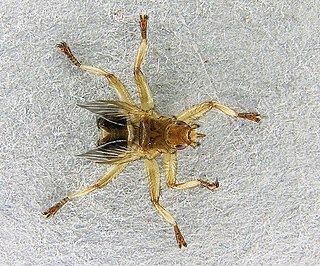
Hippoboscidae, the louse flies or keds, are obligate parasites of mammals and birds. In this family, the winged species can fly at least reasonably well, though others with vestigial or no wings are flightless and highly apomorphic. As usual in their superfamily Hippoboscoidea, most of the larval development takes place within the mother's body, and pupation occurs almost immediately.
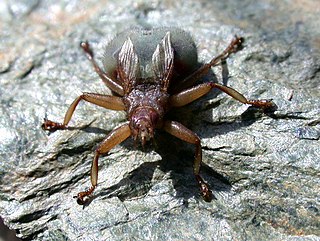
Crataerina is a genus of louse flies in the family Hippoboscidae. All are parasites of birds, feeding on the blood of various species of Apodidae (swifts) and Hirundinidae. The genus is sometimes spelled Craterina.
Hippoboscinae is a subfamily of the fly family Hippoboscidae. All are parasitic, and unlike some other members of the Hippoboscidae, all Hippoboscinae are winged species.
Lipoptena mazamae, the Neotropical deer ked, is a fly from the family Hippoboscidae. They are blood-feeding parasites of the white-tailed deer - Odocoileus virginianus in the southeastern United States and Central America, the red brocket deer - Mazama americana in Mexico to northern Argentina, and also an incidental parasite of domestic cattle, Cougars - Puma concolor, and man.
Lipoptena depressa, or the Western American deer ked, is a fly from the family Hippoboscidae and 1 of 3 flies within the genus Lipotena. They are blood-feeding parasites of the mule deer - Odocoileus hemionus in the western United States and Canada particularly in regions containing the Rocky Mountains.
Neolipoptena ferrisi, or the Pacific deer ked, is a species of fly from the family Hippoboscidae. They are blood-feeding parasites of the mule deer - Odocoileus hemionus, the white-tailed deer - Odocoileus virginianus & The Pronghorn - Antilocapra americana. They are found from British Columbia, Canada, to Baja California, Mexico.
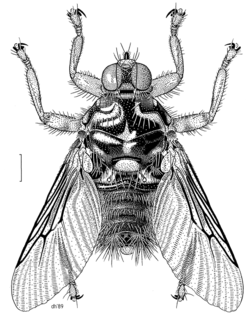
Hippobosca equina, also known as the forest fly or New Forest fly, is a biting fly from the family Hippoboscidae. They are blood-feeding ectoparasites of primarily horses and other large mammals including cattle. It is a permanently fully winged fly, not shedding its wings on finding its host, as in some other Hippoboscidae. With its wings retained, it may thus fly away from its host to deposit its larvae. They are good fliers.

Hippobosca is a genus of flies in the family Hippoboscidae. There are seven known species. There are numerous synonyms.
Microlynchia is a genus of biting flies in the family of louse flies, Hippoboscidae. There are four known species. All species are parasites of birds. Microlynchia differs from Pseudolynchia in the presence of minute ocelli and a differently shaped scutellum.

Melophagus is a genus of biting flies in the family of louse flies, Hippoboscidae. There are three known species and one subspecies. All are parasites of bovids. All are wingless.
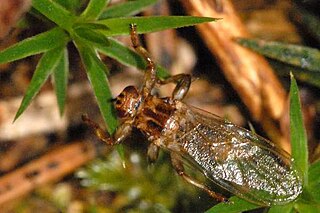
Ornithomya are genus of biting flies in the family of louse flies, Hippoboscidae. There are 29 known species. All species are parasites of birds.
Ornithophila are a genus of biting flies in the family of louse flies, Hippoboscidae. There are two known species. Both species are parasites of birds.
Proparabosca is a genus of biting flies in the family of louse flies, Hippoboscidae. There is only one known species, Proparabosca alata(Theodor & Oldroyd,1965). It is a parasite of lemurs.

Ornithomyinae is a subfamily of the fly family Hippoboscidae. All are blood feeding parasites, for the most part on birds, though some have mammals as hosts.
Crataerina pacifica is a species of biting fly in the family of louse flies Hippoboscidae. It has been found in the nest of the Pacific swift.
Crataerina melbae is a species of biting fly in the family of louse flies Hippoboscidae. Its hosts are swift species including the Alpine, Pacific, Common and mottled swifts.
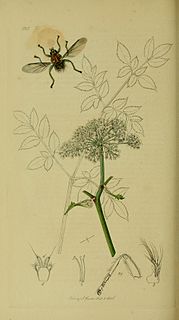
Ornithomya fringillina is a species of fly in the family Hippoboscidae. It is found in the Palearctic.

Ornithomya avicularia is a species of fly in the family Hippoboscidae. It is found in the Palearctic.









